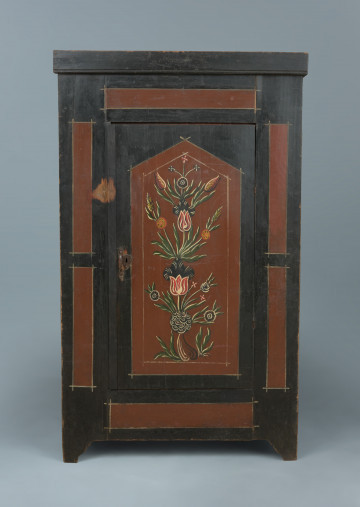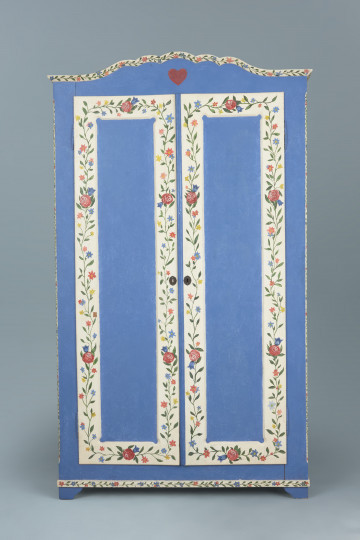
One-door wardrobe withmotif ofbouquets
XIX wiek
National Museum in Szczecin
Part of the collection: Material culture of West Pomerania
“By the wedding door: a large, ornate peasant chest, painted in garish flowers and gaudy ornaments (...)”, as Stanisław Wyspiański described in The Wedding. Painted chests were one of the most distinctive pieces of equipment found in the farmhouses. They began to emerge in the 18th century, and by the following century, they were already extremely popular. The chests were made in craft workshops and they were usually decorated by the wives and daughters of carpenters. Initially, the decorations were rather limited, but in the 19th century, they were enriched and expanded. At a time when wardrobes were not affordable and available to everyone, chests were used to store clothes. Apart from their practical use, they also had an important social role – they were a part of the bride’s dowry. Sometimes the parents would buy a chest for their daughter in advance and began gathering the dowry in it. The chest filled to the brim, heavy with the goods inside, was a sign of the girl’s great matrimonial attractiveness and was a source of pride. It was kept in a special place of honour in the home of a young married woman. In multi-generational households there were at least as many chests as there were women living in them – each had her own. By the end of the first half of the 20th century, painted chests had fallen out of favour. They ended up in attics or granaries, where they were used to store grain or potatoes. Soon their prestigious status was forgotten. Chests and trunks constitute more than 30% of the furniture collection of the Department of Ethnography of Pomerania of the National Museum in Szczecin. The chest on display was probably made in 1796, as evidenced by the inscription on its face. It is painted, with the exception of the back wall, in dark green and decorated with a plant ornament in yellow with red elements. Such a contrasting combination of colours – a uniform, cold background with decorations in warm colours – was typical for Pomeranian furniture. The chest was originally part of the collection of the Pommersches Landesmuseum Stettin.
Agnieszka Słowińska
Author / creator
Dimensions
cały obiekt: height: 74 cm, width: 127 cm
Object type
furniture
Creation time / dating
Creation / finding place
Identification number
Location / status

XIX wiek
National Museum in Szczecin

1. połowa XIX wieku
National Museum in Szczecin

1853
National Museum in Szczecin
DISCOVER this TOPIC
Museum of King Jan III's Palace at Wilanów
DISCOVER this PATH
Educational path